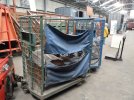You'd never get these past a risk assessment today.
Back injuries, trips and falls, trap/pinch/crush injuries, damaged goods. The two piece fabric gate is one of those classic things that looks excellent on a drawing board and even a prototype, but causes more problems than it solves in the real world.
The museum presentation feels realistic tbh. A heavy trunk, a few sacks and a bike. ~60% of the load space and >90% of the load weight, wasted. If the traffic was any higher, you'd certainly need to get creative, and extremely sweaty. So I doubt it was.
Right idea. Moving stuff between platform and handing areas on trolleys, not loading individual items onto or out of trains. Just entirely wrong implementation. Unthinkable waste for a private company. Job creation scheme and sort of kind of modernisation for a nationalised railway.
Not that you'd get much job satisfaction building these if you'd previously been making steam locomotives I would have thought. But if you've put down roots in Swindon, or are a third generation railway man, I guess you just knuckled down.
Surely it was only the pay and perks that kept the handlers interested, given there would have been plenty of opportunities opening up in the road haulage and warehousing sector even back then. Or maybe not. Sick man of Europe and all that.



